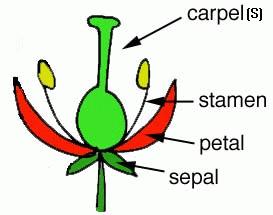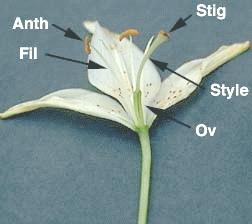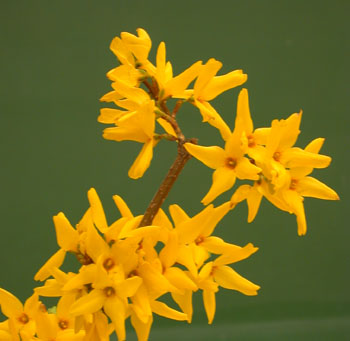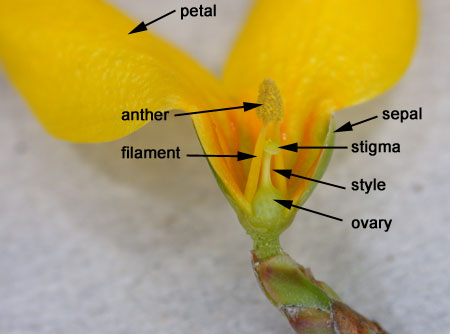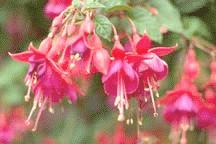1. MORPHOLOGY OF FLOWERS
In this section we will examine the general structure of the flower. The flower is the main distinguishing characteristic of the angiosperms. We will look at the generalized flower to familarize you with flower parts. Although flowers come in various shapes, sizes and colours, they are all based on the same plan. The variation we observe reflects the many ways by which reproduction is accomplished.
A flower is a specialized reproductive shoot consisting of an axis bearing a maximum of four sets of ‘appendages’: sepals, petals, stamens, and carpels. If all four sets of appendages are present, the two outer sets are sterile. The outermost ones are the sepals. These are usually greenish, leaflike, and in the bud they cover the other flower parts. The sepals are collectively known as the calyx. Inside the calyx are the petals, which are usually more brightly colored and less leaflike than the sepals. Collectively they are known as the corolla. The calyx and corolla together are known as the perianth.
Look at the different whorls of flower parts in this cross-section through the flower bud of lily. Lilies are monocots. Monocots have flower parts in whorls of threes (or multiples of threes). All the whorls here are in threes, except for the stamen which you can see there are six of (a multiple of three).Do you know how MONOCOTS and EUDICOTS differ in other ways as well?
The two innermost sets of appendages are concerned directly with reproduction. In lily the sepals and petals look almost identical and are thus called tepals. To the inside of the perianth are the stamens. The stamen is made up of an anther (Anth) and a filament (Fil). In the middle are the carpels. In this case they are fused to form a structure with and ovary (Ov), style (Style) and stigma (Stig).
In lab you looked at Forsythia. It has its petals and sepals in fours.
Here is a close-up of the flower in longitudinal section.
Flowers come in many shapes, sizes and colours. Their morphology is important because they must be attractive to the vectors that pollinate them. In this section we will examine only a few aspects of flower morphology. Keep in mind that there is much more “out there”.
1. MORPHOLOGY OF FLOWERS
Androecium
Gynoecium
Floral Morphologies
2. DEVELOPMENT OF OVULE AND SEED
DEVELOPMENT OF FEMALE GAMETOPHYTE
3. FLOWERS OF SELECTED SPECIES


